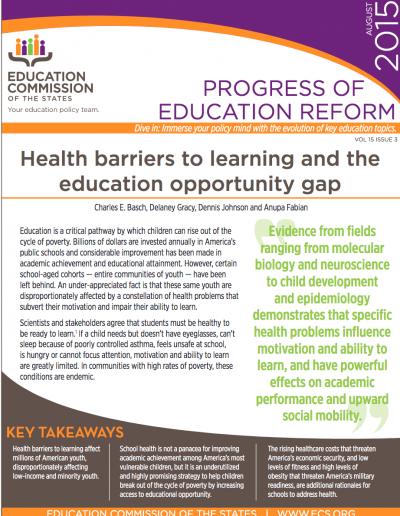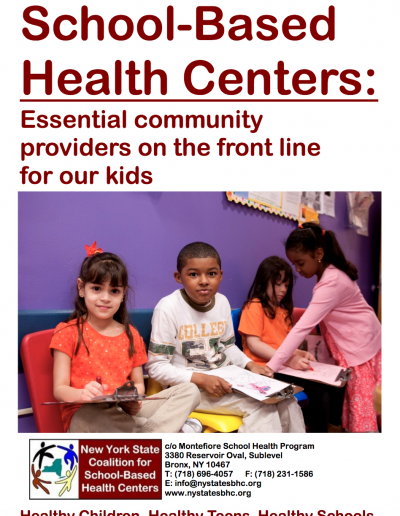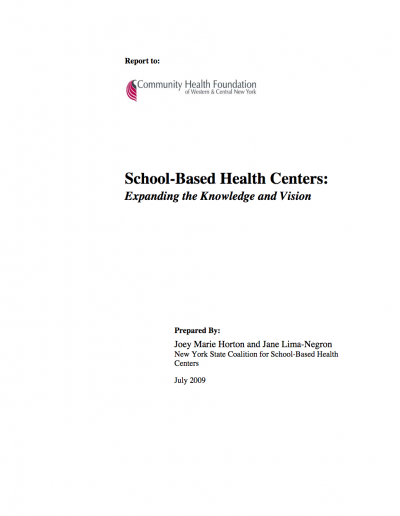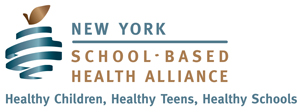NYSBHA Publications & Reports






Links:
- NYSBHA Annual Report 2017
- NYSBHA Annual Report 2016
- Health Barriers to Learning & the Education Opportunity Gap
- NYSBHA Annual Report 2014
- Essential Community Providers on the Front Line for our Kids: School-Based Health Center Advocacy
- School-Based Health Centers: Expanding the Knowledge and Vision: Education and the SBHC model
Learnings from SBHCs
This section contains various literature we want to highlight that details the benefits of School-Based Health Centers (SBHCs) and provides lessons learned in growing SBHCs. Click on the button below to to explore more than 140 peer-reviewed articles that have been published about SBHC from the 1970s to the present

- School-centered approaches to improve community health: lessons from school-based health centers
- School-based Health Centers in New York State: Ensuring Sustainability & Establishing Opportunities for Growth
- The Impact of School-Connected Behavioral and Emotional Health Interventions on Student Academic Performance
NYSBHA Fact Sheets
The Facts:
- A study by Johns Hopkins University found that school-based health centers reduced inappropriate emergency room use among regular users of school-based health centers.1,2
- A study of school-based health center costs by Emory University School of Public Health attributed a reduction in Medicaid expenditures related to inpatient, drug and emergency department use to use of school-based health centers.3
- School-based health centers have demonstrated that they attract harder-to-reach populations, especially minorities and males, and that they do a better job at getting them crucial services such as mental health care and high-risk behavior screens. Two studies found adolescents were 10-21 times more likely to come to a SBHC for mental health services than the community health center network or HMO.4,5
- A national multi-site study of school-based health centers conducted by Mathmatica Policy Research found a significant increase in health care access by students who used school-based health centers: 71% of students reported having a health care visit in past year compared to 59% of students who did not have access to a SBHC.6
- A study of elementary school-based health centers conducted by Montefiore Medical Center found a reduction in hospitalization and an increase in school attendance among inner-city school children for asthma.7 Another study on school-based health care’s effects on asthma found decreases in hospitalization rates of 75-85% and improvements in the use peak flow meters and inhalers.8
- Adolescents who received counseling services in a school-based health center significantly decreased their absenteeism and tardiness, while those not receiving counseling slightly increased their absence and tardiness rates.9
- A study of student users of health centers found that students who reported depression and past suicide attempts were significantly more willing to use the clinic for counseling services. Those with perceived weight problems reported more willingness to use a school clinic for nutrition information than those who did not feel overweight. Sexually active students were willing to seek information on pregnancy prevention and to have general disease checks.10
- Dallas school-based health centers found that medical services helped decrease absences by 50% among students who had three or more absences in a six-week period; students who received mental health services had an 85% decline in school discipline referrals.11
1. Key JD, Washington EC, Hulsey TC. Reduced Emergency Department Utilization Associated with School-Based Clinic Enrollment. Journal of Adolescent Health. Apr 2002;30(4):273-278.
2. Santelli J, Kouzis A, Newcomer S. School-Based Health Centers and Adolescent Use of Primary Care and Hospital Care. Journal of Adolescent Health. 1996;19:267-275.
3. Adams EK, Johnson V. An Elementary School-Based Health Clinic: Can it Reduce Medicaid Costs? Pediatrics. Apr 2000;105(4 Pt 1):780-788.
4. Juszczak L, Melinkovich P, Kaplan D. Use of Health and Mental Mealth Services by Adolescents Across Multiple Delivery Sites. Journal of Adolescent Health. Jun 2003;32(6 Suppl):108-118.
5. Kaplan D, Calonge B, Guernsey B, Hanrahan M. Managed Care and School-based Health Centers: Use of Health Services. Archives of Pediatric and Adolescent Medicine. 1998;152:25-33.
6. Kisker EE, Brown RS. Do School-Based Health Centers Improve Adolescents Access to Health Care, Health Status, and Risk-Taking Behavior? Journal of Adolescent Health. 1996;18:335-343.
7. Webber MP, Carpiniello KE, Oruwariye T, Lo Y, Burton WB, Appel DK. Burden of Asthma in Inner-City Elementary Schoolchildren: Do School-Based Health Centers Make a Difference? Archives of pediatrics & adolescent medicine. Feb 2003;157(2):125-129.
8. Lurie N, Bauer EJ, Brady C. Asthma Outcomes at an Inner-City School-Based Health Center. J Sch Health. Jan 2001;71(1):9-16.
9. Gall G, Pagano ME, Desmond MS, Perrin JM, Murphy JM. Utility of Psychosocial Screening at a School-Based Health Center. Journal of School Health. Sep 2000;70(7):292-298.
10. Riggs S, Cheng T. Adolescents Willingness to Use a School Based Clinic in View of Expressed Health Concerns. Journal of Adolescent Health Care. 1988;9(208-213).
11. Dallas Youth and Family Centers Program: Hall L. Final Report undefined Youth and Family Centers Program 2000–2001 Dallas, TX: Dallas Independent Schools District;2001.
The Facts:
- High school SBHC users in one 2000 study had a 50% decrease in absenteeism and 25% decrease in tardiness two months after receiving school-based mental health and counseling.2
- A study of SBHC users in Seattle found that those who use the clinic for medical purposes had a significant increase in attendance over nonusers.3
- A 2007 study found that SBHC users for mental health purposes increased their Grade Point Averages over time compared to nonusers.3
- African-American male SBHC users were three times more likely to stay in school than their peers who did not use the SBHC.4
- Students, teachers, and parents who have a SBHC rated academic expectations, school engagement, and safety and respect significantly higher than in schools without a SBHC.5
- SBHCs in The Bronx, NY reduced hospitalization and increased school attendance among school children with asthma.6
- A quasi-experimental study in New York observed that students not enrolled in a SBHC lost three times as much seat time as students enrolled in a SBHC.
Click Here to Download the School-Based Health Centers and Academic Success PDF
1. Basch CE. Healthier Students Are Better Learners: A Missing Link in School Reforms to Close the Achievement Gap. 2010.
2. Gall G, Pagano ME, Desmond MS, Perrin JM, Murphy JM. Utility of Psychosocial Screening at a School-Based Health Center. Journal of School Health. Sep 2000;70(7):292-298.
3. Walker SC, Kerns SE, Lyon AR, Bruns EJ, Cosgrove TJ. Impact of School-Based Health Center Use on Academic Outcomes. The Journal of adolescent health : official publication of the Society for Adolescent Medicine. Mar 2010;46(3):251-257.
4. McCord MT, Klein JD, Foy JM, Fothergill K. School-Based Clinic Use and School Performance. Journal of Adolescent Health. 1993;14(2):91-98.
5. Strolin-Goltzman J. The Relationship Between School-Based Health Centers and the Learning Environment. Journal of School Health. 2010;80(3):153-159.
6. Webber MP, Carpiniello KE, Oruwariye T, Lo Y, Burton WB, Appel DK. Burden of Asthma in Inner-City Elementary Schoolchildren: Do School-Based Health Centers Make a Difference? Archives of pediatrics & adolescent medicine. Feb 2003;157(2):125-129.
7. Van Cura M. The Relationship Between School-Based Health Centers, Rates of Early Dismissal from School, and Loss of Seat Time. J Sch Health. 2010;80(8):371-377.
The Facts:
Research and evaluations have demonstrated that school-based health centers represent cost-effective investments of public resources:
- A study by Johns Hopkins University found that school-based health centers reduced inappropriate emergency room use, increased use of primary care, and resulted in fewer hospitalizations among regular users.1
- A study of Medicaid-enrolled children served by a SBHC in Atlanta, Georgia found significantly lower inpatient, nonemergency department transportation, drug, and emergency department Medicaid expenses as compared to children without a SBHC. In 1996 the total yearly expense per individual for the SBHC was $898.98, as compared to $2360.46 for individuals without a SBHC.2
- The number of hospitalizations and emergency department visits decreased for children with SBHCs in Cincinnati schools (2.4-fold and 33.5% respectively) – with an estimated savings of nearly $1,000 per child.3
- Students in New York City schools with SBHCs were less likely to have been hospitalized for asthma at least once in the past year (10.5%) compared to those in schools without SBHCs (17.1%).4
- In South Carolina, prevention-oriented health care provided in a SBHCdecreased emergency department visit rates by 41% to 57% — 18% greater than the decrease in students who did not use the SBHC.5
- Adolescents with access to SBHCs in Denver had 38% – 55% fewer after-hours care (emergent or urgent) visits than those without school-based health center access.6
- Students in Ohio who used an SBHC reported more positive self-perceptions of their health, which correlated with lower Medicaid costs. SBHC patients cost Medicaid an average of $30.40 less than comparable, non-SBHC patients.7
- A study that explored the cost-benefit of a nationwide SBHC program to manage childhood asthma estimated total savings for opportunity costs of work loss and premature death at $23.13 billion.8
Click Here to Download the Cost-Savings of School-Based Health Centers PDF
1. Santelli J, Kouzis A, Newcomer S. School-Based Health Centers and Adolescent Use of Primary Care and Hospital Care. Journal of Adolescent Health. 1996;19:267-275.
2. Adams EK, Johnson V. An Elementary School-Based Health Clinic: Can it Reduce Medicaid Costs? Pediatrics. Apr 2000;105(4 Pt 1):780-788.
3. Guo JJ, Jang R, Keller KN, McCracken AL, Pan W, Cluxton RJ. Impact of School-Based Health Centers on Children with Asthma. Journal of Adolescent Health. Oct 2005;37(4):266-274.
4. Webber MP, Carpiniello KE, Oruwariye T, Lo Y, Burton WB, Appel DK. Burden of Asthma in Inner-City Elementary Schoolchildren: Do School-Based Health Centers Make a Difference? Archives of pediatrics & adolescent medicine. Feb 2003;157(2):125-129.
5. Key JD, Washington EC, Hulsey TC. Reduced Emergency Department Utilization Associated with School-Based Clinic Enrollment. Journal of Adolescent Health. Apr 2002;30(4):273-278.
6. Kaplan D, Calonge B, Guernsey B, Hanrahan M. Managed Care and School-based Health Centers: Use of Health Services. Archives of Pediatric and Adolescent Medicine. 1998;152:25-33.
7. Wade TJ, Guo JJ. Linking Improvements in Health-Related Quality of Life to Reductions in Medicaid Costs Among Students Who Use School-Based Health Centers. American journal of public health. Sep 2010;100(9):1611-1616.
8. Tai T, Bame SI. Cost-Benefit Analysis of Childhood Asthma Management Through School-Based Clinic Programs. J Community Health. Apr 2011;36(2):253-260.
The Facts:
School-based health centers (SBHCs) are the ideal location for primary care and mental health staff to collaboratively address students’ physical and mental health needs – leading to greater success in school and in life.
- Seventy-five percent of SBHCs have a mental health provider.1
- In studies of SBHC service utilization, mental health counseling is repeatedly identified as the leading reason for visits by students.2
- One 1998 study found that adolescents who had access to SBHCs were ten times more likely to make a mental health or substance abuse visit than those without access to an SBHC.3
- In one study, inner-city students were 21 times more likely to make mental-health related visits to SBHCs than to community health centers.4
- A national survey of SBHCs found the following mental health and counseling services are provided at SBHCs where mental health professionals are included as center staff: crisis intervention, mental health assessment, grief and loss therapy, substance use therapy, mediation, and others.1
- School-based health centers offer high quality mental health care by using an integrated strategy for addressing health and mental health issues. Several studies have shown that the barriers experienced in traditional mental health settings (2) – stigma, non-compliance, inadequate access – are overcome in school-based settings.2,5
- One study found that students served by SBHCs had fewer discipline problems, course failures, and school absences.6
Click Here to Download the School-Based Health Centers: On the Front Line for Mental Health PDF
1. Strozer J JL, Ammerman A. 2007-2008 National School-Based Health Care Census. . Washington, DC: National Assembly on School-Based Health Care;2010.
2. Waszak C, Neidell S. School-Based and School-Linked Clinics: Update 1991. Washington, DC: Center for Population Options; 1991.
3. Kaplan D, Calonge B, Guernsey B, Hanrahan M. Managed Care and School-based Health Centers: Use of Health Services. Archives of Pediatric and Adolescent Medicine. 1998;152:25-33.
4. Juszczak L, Melinkovich P, Kaplan D. Use of Health and Mental Mealth Services by Adolescents Across Multiple Delivery Sites. Journal of Adolescent Health. Jun 2003;32(6 Suppl):108-118.
5. Anglin TM, Naylor KE, Kaplan DW. Comprehensive School-Based Health Care: High School Students’ Use of Medical, Mental Health, and Substance Abuse Services. Pediatrics. 1996;97(3):318-330.
6. Jennings J, Pearson G, Harris M. Implementing and Maintaining School-Based Mental Health Services in a Large, Urban School District. J Sch Health. May 2000;70(5):201-205.
SBHCs and school nurses know that healthy students learn better. They share an important mission: providing preventive care for all students they serve, with the goal of keeping students in class learning.
Click Here to Download the School-Based Health Centers and School Nurses PDF
SBHCs and School Nurses
- Educate students and families about healthy behaviors and nutrition
- Enroll students and families in public insurance programs
- Offer immunizations
Benefits of Working Together
- Enhance students’ health, academic outcomes, and overall well-being
- Plan and implement health promotion and disease prevention programs
- Increase information sharing to protect student privacy and continuity of care
- Reduce emergency room visits and hospitalizations
- Detect health problems before onset of chronic conditions
